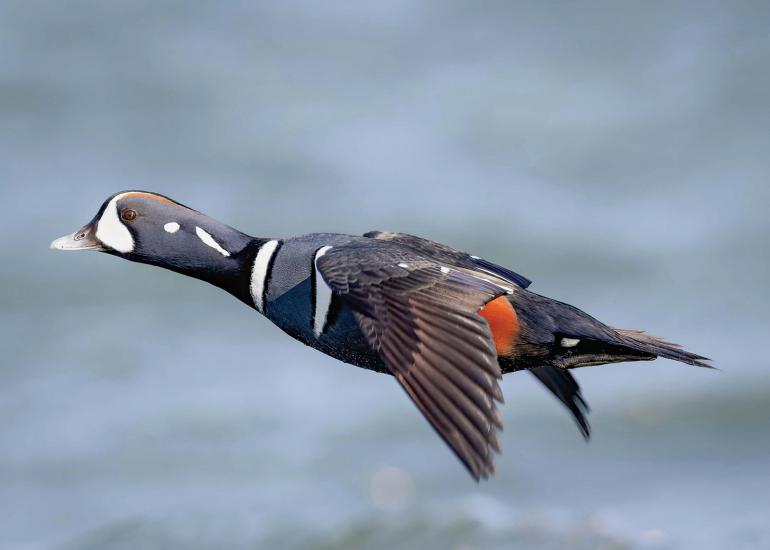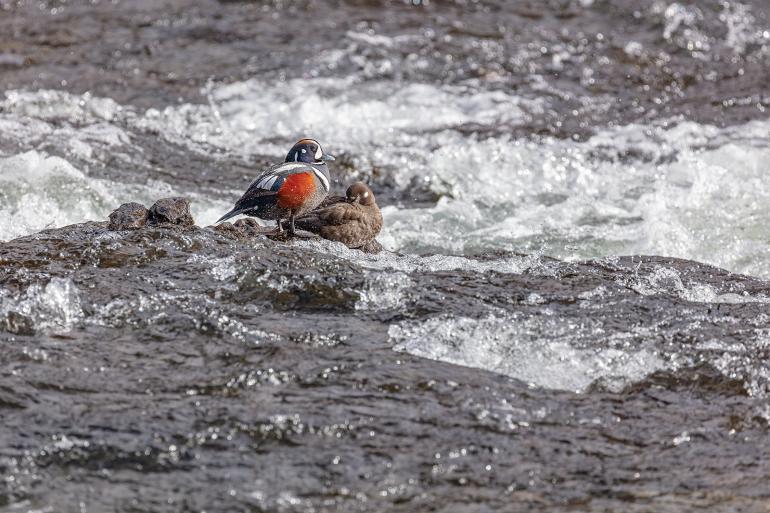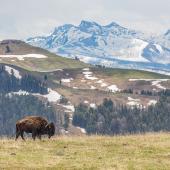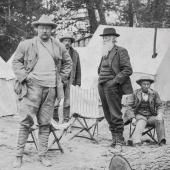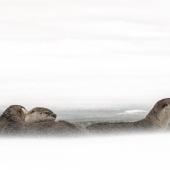A Romance of Harlequins
The theatrical bird of Yellowstone.
One of the first historical records of harlequin ducks appeared in a 1747 volume titled A Natural History of Uncommon Birds by the British naturalist George Edwards. Nearly three centuries later, they’re still an uncommon species, even though we know far more regarding their range and biology than Edwards did. Harlequins inhabit northern climates, including Alaska, Siberia and the northern reaches of eastern Canada. Of the population occupying the western side of North America, harlequins breeding in northern and western Wyoming and Montana represent the southernmost and easternmost segments of the population.
Among birders, harlequin sightings are coveted not solely on the basis of their scarcity. The birds are also “uncommon” in their appearance, at least the males. The plumage of the drakes is a chaotic amalgam of rusty orange, dark blue, gray, white, and black hues arranged in streaks, blotches and dots. The name “harlequin” itself stems from similarly colorful roots: specifically an early form of theatre during the Renaissance known as “Italian comedy” or commedia dell’arte. Outlandish costumes with vivid colors were staples of such shows. The actors so portrayed were dubbed “Harlequins.” Even the scientific name for the colorful ducks (histrionicus histrionicus) hearkens to this theatrial reference. “Histrionicus” in Latin refers directly to the theatre, and sometimes specifically to the Harlequins of the commedia dell’arte.
Although numbers of harlequin ducks are declining over most of their breeding range in the United States, we residents of the Gallatin Valley have excellent odds of sighting these fascinating birds just over the mountains in Yellowstone National Park. Harlequins congregate at LeHardy Rapids on the Yellowstone River in late spring. Mated pairs begin arriving in late April to early May. They typically hang around the LeHardy area for several weeks before dispersing to nesting sites. Yellowstone visitors infrequently encounter harlequins on smaller streams such as Soda Butte Creek. They may also hang out on other parts of the Yellowstone River. Pairs have been sighted in the rapids around Tower Junction. The most reliable window to ogle the LeHardy harlequins occurs within a week on either side of May 15.
The name “harlequin” itself stems from colorful roots: specifically an early form of theatre during the Renaissance known as “Italian comedy” or commedia dell’arte.
The intriguing, gaudy plumage of the drakes immediately catches the eyes of birders fortunate enough to spy the Yellowstone harlequins. But rather than snapping a few photos and checking the birding box, take some time to aquaint yourself with the life history of these birds—it’s as fascinating as their appearance. Unlike mallards or teal that communicate with various quacks and chuckles, harlequins vocalize in tones often likened to the squeaks of mice. Harlequins are considered a diving duck, but unlike canvasbacks and scaup that plummet to lake bottoms, their feeding habits more closely resemble those of American dippers. In fact, you’ll frequently see dippers and harlequins sharing the rocks in the LeHardy rapids, both species plunging into the water to nab small crustaceans and aquatic insects.
Then, come mating season, breeding pairs claim nesting sites along small, swiftly flowing streams. In addition to Yellowstone, harlequins rear young along freshets in the Absaroka-Beartooth Wilderness, along the Rocky Mountain Front, in Glacier National Park, and on other major and minor streams in western Montana. Females normally locate their nests within three feet of rushing water. Surveys from MacDonald Creek in Glacier National Park indicate most harlequin chicks are hatched from late June to early July. Harlequin drakes are the “deadbeat dads” of the waterfowl world. By the time their chicks have hatched, they’ve typically departed to wintering grounds on the west coast. Most of the Yellowstone-area harlequins winter in the vicinity of Vancouver Island, British Columbia.
The long-term viability of the species in Montana (and elsewhere) is clouded with uncertainty. Most populations are in a steady, long-term decline. Nests are vulnerable to flooding. Wintering and breeding harlequins are stressed by human disturbance, be it hens abandoning nests or birds bothered on winter range. Oil spills, increased human presence in nesting areas, and extreme changes in water volume in breeding habitat are among the greatest concerns of those entrusted with the management of this “uncommon” bird.
No matter where harlequins are found, birdwatchers can’t help but develop a romance with them. Let’s hope the love affair yields more than a fleeting infatuation, but a long-term commitment to enhancing the well-being of the beloved.


